|
 Menhirs, Obelisks and Standing Stones:
(Form and Function)
Menhirs, Obelisks and Standing Stones:
(Form and Function)
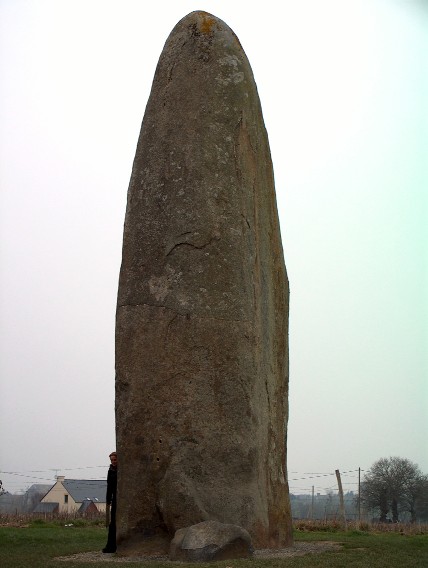
The 'wholesale'
appearance of menhirs began in Neolithic Europe, at around 4,000 BC, the
same time as the first Egyptian obelisks (See Nabta Playa). While the Egyptian
obelisks were later carved with flattened faces, the European menhirs were shaped and
smoothed so that with a few exceptions, the builders retained and even
emphasised the natural qualities of the stones they used.
Although there are suggestions of astronomical
significance at many of the larger menhirs, it by no way means that that this was true for all menhirs. There are
several examples of prominent stones being border markers, although this is
most likely to have been a secondary usage. For example, the stone at
Champs Dolent,
in France (right), defines the border between Brittany and Normandy, but is also
part of an older (solar) landscape alignment including nearby
Mont St.
Michel.
The largest recorded standing stones of all time were all
Egyptian. The two ancient Egyptian capital's of
Heliopolis and Karnak were marked by huge obelisks.
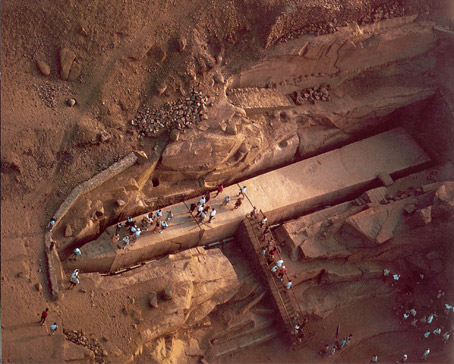
The Egyptian obsession with
obelisk building led them to produce several of the largest
standing stones from the ancient world.
The largest known Egyptian obelisk
is the 'unfinished obelisk', which was left
in-situ, attached to
the living rock, following the discovery of a natural fissure in the rock.
The
stone was carved to 120-feet (36m) in length and would have weighed over
1000 tons when complete.
(More about the
unfinished obelisk)
Most of the largest obelisks
have been 'removed' from Egypt and now stand at other locations
around the world. Of 28 ancient Egyptian obelisks discovered
only 8 large ones remain in Egypt.
The Remaining Eight Egyptian Obelisks :
|
Location : |
Pharaoh : |
Details : |
| Karnak temple,
Thebes. |
Tuthmosis I
|
66-75ft -
(143-160 tons). |
| Karnak temple,
Thebes. |
Hatshepsut (fallen) |
97ft - (320-323 tons). |
| Karnak temple,
Thebes. |
Seti II |
7m. |
| Luxor temple,
Luxor. |
Ramses II |
82ft - (254 tons). |
| Luxor Museum. |
Ramses II |
|
| Heliopolis, Cairo. |
Senusret
I |
20.4m - 20.75m (120 tons). |
| Gezira Island,
Cairo |
Ramses II |
20.4m high.
(120 tons). |
| Cairo
International Airport. |
Ramses II |
16.97m high.
(110 tons). |
The following obelisks
were
all once Egyptian. They are now located at significant sites around the
world.
|
Location : |
Pharaoh : |
Details : |
| Lateranense,
Vatican city, Rome. |
Tuthmosis III / IV |
32.18m high
(weight - 330 tons)
(4m lost during 1587 restoration)
|
| Vaticano,
St. Peters square, Rome. |
Nebkaure Amenemhat
II ?? |
25.5m high, 320
tons |
| Flaminio,
Piazza del Popolo, Rome. |
Seti I - Ramses II |
24m high, (235+
tons.) |
| Solare,
Piazza di Monteciterio, Rome. |
Psammetichus II |
21.79m high, (230
tons) |
| Square of Horses,
Istanbul, Turkey. |
Tuthmosis III |
19.6m high.
(weight - 175 tons)
(Bottom 10.4m lost - orig:
380-400 tons)
|
|
Place de Concorde, Paris.
France. |
Ramses II |
23m (74ft) high (weight 227-250 tons) |
| Cleopatra's
needle, London. |
Tuthmosis III |
20.87m (69ft)
high (weight 187+ tons) |
| Cleopatra's
needle, New York. |
Tuthmosis III |
21m (70ft) high
(weight 193+ tons) |
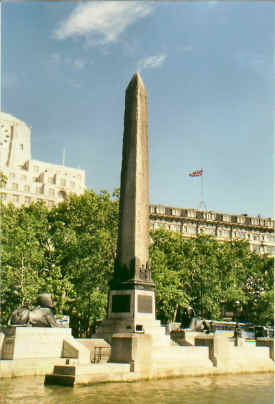 |
 |
 |
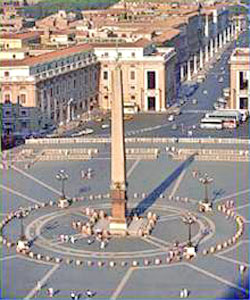 |
|
Cleopatra's Needle, London. |
Place de Concorde,
Paris. |
Cleopatra's needle, New York. |
Lateran Obelisk, Vatican City. |
|

Heliopolis.
The obelisk at Heliopolis
(On, Annu) in Egypt, represented the very epicentre of sun worship in early dynastic
Egypt. Many of the most significant (3rd to 6th dynasty) pyramids were built
so as to produce corner alignments with Heliopolis.
The obelisk at
Heliopolis
was erected by Sesostris I at around 2,433 BC (Brugsch). The orientation of
the obelisk led Lockyer to suggest that Heliopolis may have been constructed
over an older temple which was first used for observations of Dubhe (Ursae
Majoris). In which case 'the original foundation stone was laid about
5,100 BC' (2)
At 30�
04� N,
31� 30�
E, Heliopolis is geodetically more accurately located than Giza. It is
almost exactly 4� south and 5� west of Heliopolis (Baalbek
- 34� 03� N,
36� 10� E), in
Lebanon.
(More on this subject)
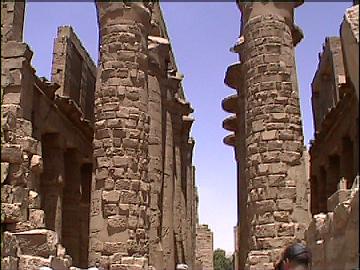
Karnak - The huge temple complex at
Karnak was shown by Lockyer
(2) to have a solar orientation (aligned to the summer solstice sunrise), which was marked out
by several of the
largest obelisks in Egyptian history.
The temple of
Amon Ra
at Karnak was considered the geodetic navel of of ancient Egypt. It is
located exactly 2/7th's of the way from the Equator to the pole. Other
ancient sites also appear to conform to this theory such as
Delphi
(3/7th's), and the
Silbury/Avebury
complex
(5/7th's).
(More about Egyptian
Geodesy)

Moving the Cleopatra's
Needle to New York.
In 1879, His
Excellency Ch�rif Pacha, the Governor of Alexandria, gave a
71-foot obelisk known as Cleopatra's Needle to the United States
Government, to be elected in the city of New York. Funding for
its transportation was provided by William H. Vanderbilt, to
whom this book was dedicated. What follows is a greatly
simplified rendition of how this 244-ton obelisk was moved, in
over a hundred stages, over a two-year period and at a cost of
approximately $100,000. Before it could be moved, it was
"staged" with scaffolding to protect the hieroglyphs, while its
foundation was unearthed. It was then hoisted onto a mechanical
contraction that turned it 90 degrees, parallel with the ground.
It was then
moved horizontally, much like pyramid stone, right onto a boat -
A steamer with a hole cut through its hull.
|
Menhir Facts:
Menhirs and standing stones in Europe were
placed into the ground, which means that they are obviously considerably
longer than they appear.
It is
reasonable to include an extra 20% in length below the ground.
An attempt to straighten the two stones
called 'The
Cove' at
Avebury in 2003, revealed the fact that
one of the stones, which stands 14ft (4.4m), above the ground, also exists
at least 7ft (2.2m) below the ground (reaching a possible 10ft /3m deep).
The weight of the stone is now calculated at around 100 tons.
Refs: Daily Telegraph News (8 April
2003); The Scotsman (17 April 2003), The Guardian (18 April 2003) |
Although the largest known
French menhir (Le
Grand Menhir Bris�)
in Morbihan, has now fallen, France still possesses several of the largest standing
menhirs in the world, a tribute to the builders skill and
determination.
The largest upright menhir in France today is the Kerloas
menhir, which stands at 9.5m.
The
Tallest Menhirs in
France:
Menhirs are found in all countries
which abound in megalithic structures. In France over 1600 isolated examples
have been recorded, of which about the half, and by far the most remarkable,
are within the five departments which constitute Brittany. Over the rest of
France they are generally small, and not to be compared in size to those of
Brittany. At
Lochmariaquer, Morbihan, is the largest menhir in the world. It was in
the form of a smooth-sided Obelisk, but now lies on the ground broken into
four fragments, the aggregate length of which amounts to 20.50 metres (about
67 ft.). It was made of granite foreign to the neighbourhood, and its
weight, according to the most recent calculations, amounted to 347,53 1
kilogrammes, or 342 tons (L'Homme,
188 5, p. 1 93). The next largest menhir is at Plesidy (Cotes-du-Nord)),
measuring about 37 ft. in height. Then follows a list of sixty-seven
gradually diminishing to 16 ft. in height of which the first ten (all above
26 ft.) are in Brittany. As regards form these menhirs vary greatly. Some
are cylindrical, as the well-known Pierre de
champ-Dolent at Dol (height 30 ft.), and that of Cadiou in Finistere
(28 ft.); while that of Penmarch (26 ft.) takes the shape of a partially
expanded fan. A menhir of quartz at Medreac (Ille-et-Vilaine) stands 162 ft.
high in the form of a rectangular pillar 'indubitablement taille'.
(3)
|
Name and Location |
Height (m) |
Height (ft) |
|
Le Grand Menhir Bris� (Morbihan)
- (Fallen) |
20.50 |
67.30 |
|
Pl�sidy
(C�tes du Nord) |
11.12 |
36.50 |
|
Kerloas (Plouarzel,
Finist�re). (Top chipped off
- currently only 9.5m)
|
11.05 |
36.25 |
|
Louargat
(C�tes
du Nord) |
10.30 |
33.80 |
|
K�rien
(C�tes du Nord) |
9.63 |
31.60 |
|
Dol (Ille-et-Vilaine) at Champ-Dolent |
9.30 |
30.50 |
|
P�dernec
(C�tes du Nord) |
8.50 |
27.90 |
|
Glomel
(C�tes du Nord) |
8.50 |
27.90 |
|
Tr�gon
(C�tes du Nord) |
8.50 |
27.90 |
|
Sca�r
(Finist�re) |
8.33 |
27.30 |
|
Pleucadeuc (Morbihan) at la
Grande-Brousse. |
8.00 |
26.25 |
|
Tr�gunc
(Finist�re) |
8.00 |
26.25 |
|
B�gard
(C�tes du Nord) |
7.50 |
24.60 |
|
Carnihuel
(C�tes du Nord) |
7.50 |
24.60 |
(Taken from an 1885 survey by Gabriel de Mortillet). (3)
Other French
Menhirs:
Le Grande
Menhir Bris� At over 20m high this was once the largest standing stone in Europe,
but archaeology has now shown it to be the last extant stone of a stone-alignment,
with another 18 other pits still visible in a row leading towards Le Grand
Menhir (see below). It is believed for several reasons, that the structure
was once used as a lunar back-sight, involving other prominent sites in the
area. and would have once been able to accurately measure the moons 18.6
year cycle.
The missing stones: The
original monument was constructed at around 4,000BC. It was
destroyed around a thousand years later and the stones were re-used for new
constructions in the area. It is suspected that the cap-stones for the
Table-des-Marchands,
Gavr'inis and
Er-Lannic tumulii are all parts of one of the original menhirs from the
construction.
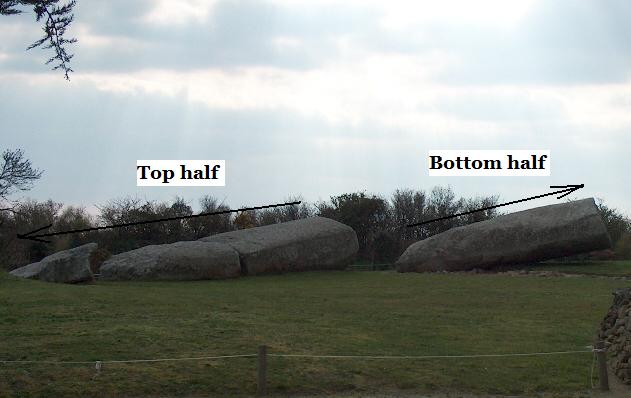
The location, and size
of the other missing stones are a matter of speculation but there are several
likely candidates in the immediate surrounding
countryside. The several phases of construction at Carnac offering the tantalising possibility that
(some of) these other stones may be the missing ones from the original Morbihan
monument.
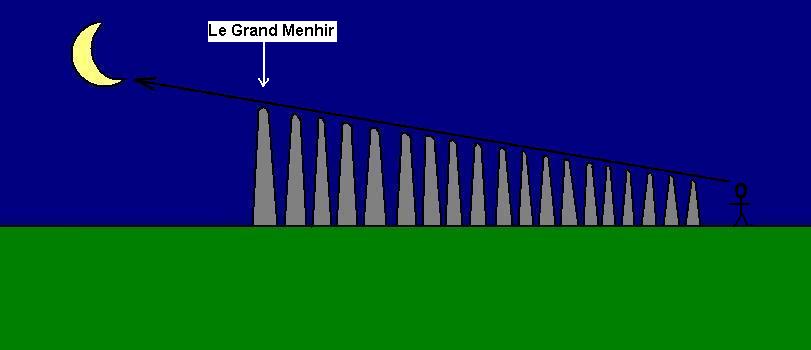
(More about
the Lochmariaquer menhirs)
The Kergadiou Menhirs:
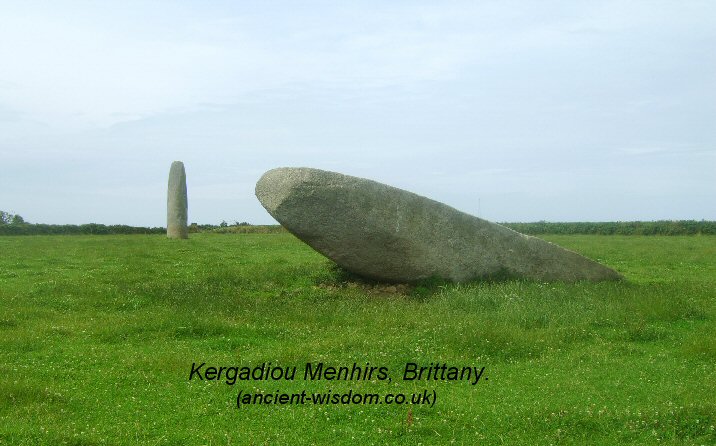
The Spectacular Kergadiou Menhirs (8.75m and 11m)
The Kergadiou menhirs were inter-visible with
the Kerloas menhir, the ocean and several other menhirs in the vicinity, The
extreme height and proximity to the ocean of many of the Brittany menhirs
makes it possible that these particular examples may have been erected with navigation in mind.
It is interesting to note that the same cannot be said of the opposite
English coastline, even though tradition claims an English origin for the
stones, suggesting a connection in the distant past.
(More
about the Kergadiou Menhirs) |
Other Menhirs in Brittany.
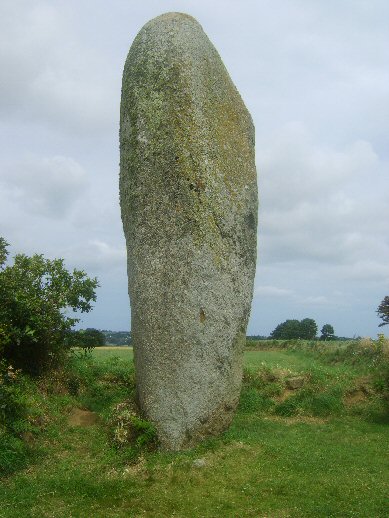

Llanoulouarn 4m (left), Coulnandre 3m (right)
|
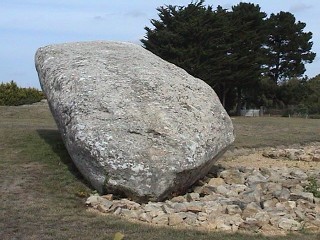 Menhir
Facts: Menhir
Facts:
It
was common practice with large European menhirs\standing-stones to shape
the bottom end of the stone into a 'keel' as seen in the photo (right), of
Le Grand Menhir
Bris� in France.
Features such as this are
a tribute to the advanced understanding of engineering possessed by the
megalithic builders.
(Prehistoric Construction Techniques) |
The British landscape
still possesses several hundreds of standing-stones. They have been the cause of
much study and have been associated with ley-lines, astronomy, geometry and
territorial markers, although it is probable that many of the larger stones
have been re-used for different purposes since they were first placed.

The Rudstone Monument - At 7.8m
high, this is the largest
standing-stone in England. The Rudstone complex includes several important
prehistoric landscape features such as Cursus' and beacon hills, both
landscape features traditionally
associated with astronomy.
(More about the Rudstone
complex)
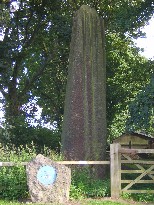
The 'Devil's Arrows' - Three standing-stones
with grooves carved into the tops and sides. The stones are almost
aligned, but not quite, reminiscent of the many 'triple-circles' in UK
showing the same layout. Having said they are not perfectly aligned,
they are orientated towards the
nearby Thornborough complex (three henges) on the Ur-Swale plateau, several
miles north. The Thornborough complex also includes a Cursus and
the region claims at least six of the largest henges in England.
(More about the
Devil's Arrows)
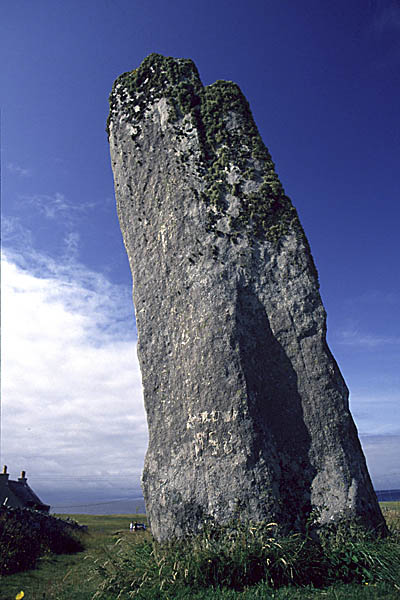
Clach-an-Trushal
- The largest standing stone in Scotland. At over 6m tall this stone has
no historical context, although it is believed that there may have once
been other structures at the site.
(More about
Clach-an-Trushal)
There are several large menhirs still standing in Portugal,
including the largest in all Iberia at just over 7m.
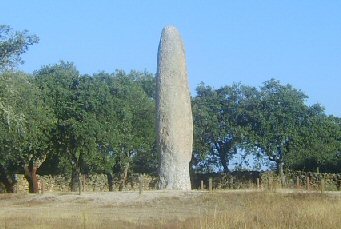
Menhir da Meada: The tallest menhir in
Portugal and all Iberia. This stone is just over 7 metres tall
and is situated near Castelo de
Vide, along with over 50 other megalithic remains.
(More about the
Menhir da Meada)
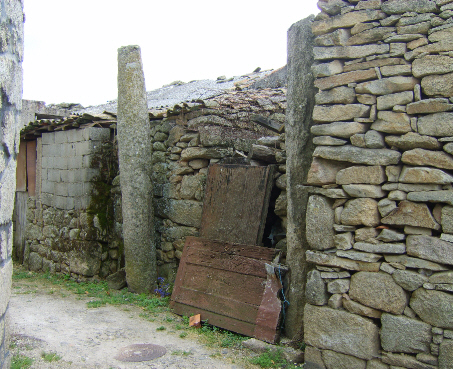
The 'Rochoso menhirs':
Originally four columns and part of an unknown monument, these
two slender stone pillars are all that remain today.
(More about Rochoso)
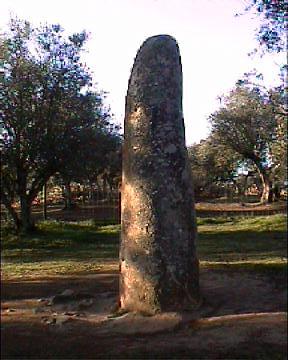
Almendres
Menhir: This stone is believed to have been a solstice marker in
relation to the nearby Almendres stone circle, one of Portugal's
prehistoric gems. It is located in the Evora region of Portugal,
which as well as having an astronomical significance, has been
continuously occupied for 20,000 years.
(More about Almendres)
(More about the Evora complex)
The Monsaraz
menhirs:
There are several
substantial menhirs in the vicinity of Monsaraz, most noticeably
those at Xarez, Outeiro and Bulhao, although several others are
recorded in the same region.
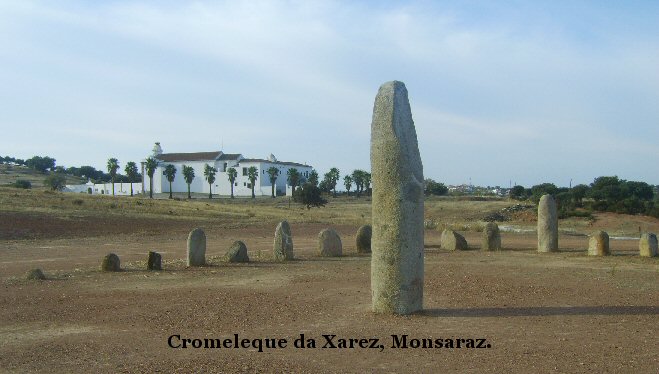
The Xarez menhir is
unique as it stands in the centre of the Cromeleque da Xarez, which
was relocated from its original location 5km south to its current
position beside Monsaraz itself following the construction of the
nearby dam in 2002. The cromeleque da Xarez has been suggested as
being part of a 50km lunar alignment (corridor of incidence), which
includes other noticeable sites such as
Almendres and
Zambujeiro.
( More
about the Xarez Alignment)
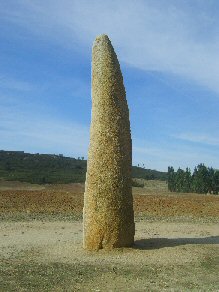
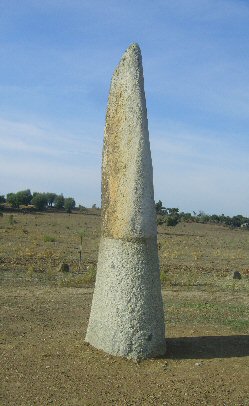
Not far North of
Monsaraz are the Outeiro
and Bulhao menhirs. The Outeiro menhir is the second tallest in
Portugal and the heavily decorated. The Bulhao menhir is one of the
oldest recognised structures in the region.
(More
about prehistoric Portugal)
Other menhirs, obelisks and standing-stones from around the world.
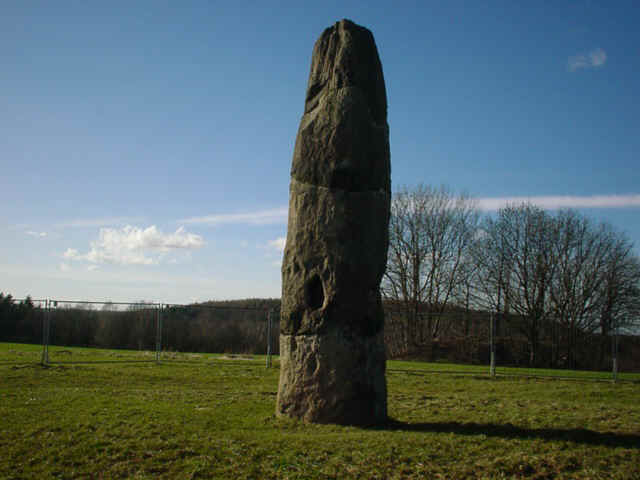
The Tallest Menhir in
Germany.
The Gollenstein (Golden stone). Height
7.6m high.
Broken and re-erected.
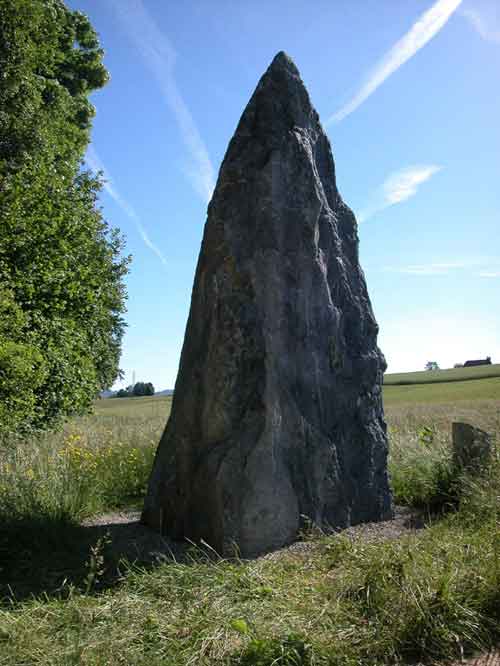
The tallest Menhir in
Switzerland.
Menhir d'essertes Auborange -
Height 5.6m (25 tons)
|












 Menhir
Facts:
Menhir
Facts:







